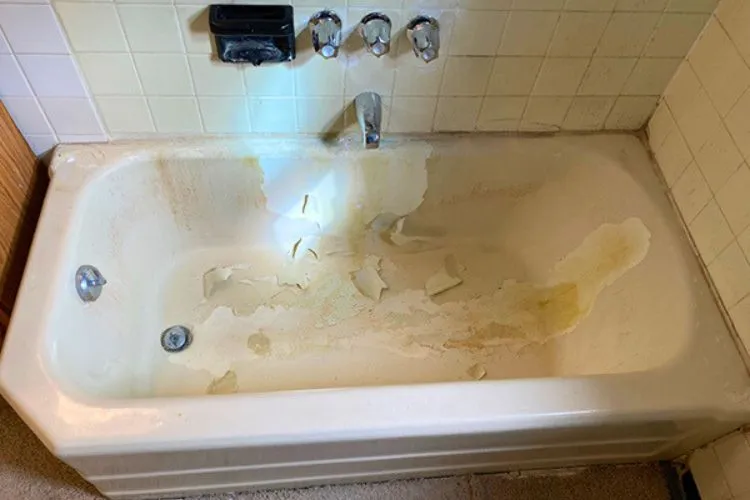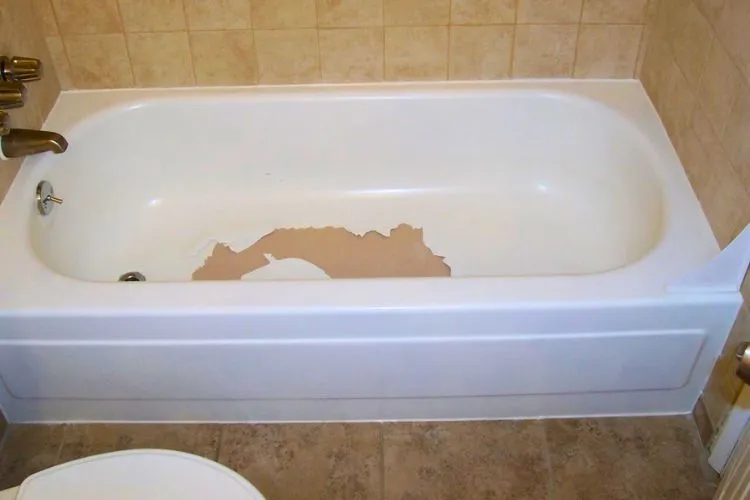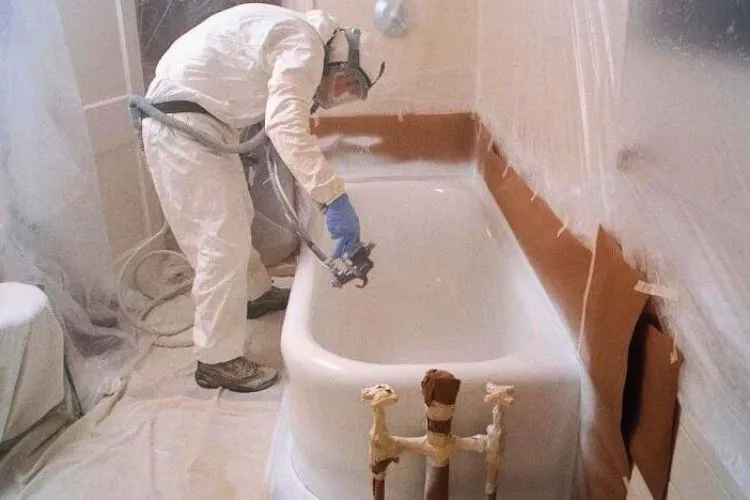Have you noticed your bathtub’s surface starting to peel? It can be a frustrating and unsightly issue to deal with, but fear not – we’re here to help!
So, why is my bathtub peeling? This question used to haunt me at night, and then I started researching about it.
In this comprehensive guide, I’ll explore the causes of a peeling bathtub, the effects it can have, and the best methods to fix and prevent further damage.

Let’s dive in!
why is my bathtub peeling? Causes of Bathtub Peeling
When searching for the reasons behind a peeling bathtub, several factors come into play. Understanding these causes is crucial to addressing the issue effectively.

Previous Refinishing
One common cause of a peeling bathtub surface is inadequate or improper bathtub refinishing. If your tub was previously refinished using low-quality materials or incorrect techniques, it can lead to premature peeling and flaking.
Moisture and Humidity
Bathrooms are prone to high levels of moisture and humidity, which can contribute to bathtub peeling. Over time, the constant exposure to water, steam, and humidity weakens the coating and causes it to deteriorate, leading to peeling.
Harsh Cleaning Products
Using abrasive or chemical-heavy cleaning products not suitable for your bathtub’s surface can strip away the protective layer, making it more prone to peeling. It’s important to use gentle, non-abrasive cleaners specifically designed for bathtubs.
Age and Wear
Just like everything else, bathtubs age too. As a bathtub gets older, the original coating can wear down, exposing vulnerable layers to potential damage. The combination of age and regular use can result in peeling and deterioration.
Harsh Water
If your water supply is hard or contains high levels of minerals, it can lead to a buildup of mineral deposits on the bathtub surface. These deposits can weaken the coating and result in peeling.
Improper Installation
If the bathtub was not installed properly, it could lead to stress on the surface, causing it to crack or peel over time.
Thermal Shock
Rapid temperature changes, such as hot water followed by cold water, can cause the coating on the bathtub to expand and contract, leading to peeling.
Chemical Reactions
Certain cleaning products, especially those containing bleach or ammonia, can react with the bathtub’s coating and cause it to peel.
It’s important to remember that these are general causes, and the specific cause of your bathtub peeling may vary. If you are unsure about the cause or how to address the issue, it may be best to consult a professional for an accurate assessment and appropriate solution.
Effects of Bathtub Peeling
A peeling bathtub isn’t only an eyesore; it can also have various negative effects on both aesthetics and functionality.
The peeling surface not only looks unappealing but can also harbor dirt, grime, and bacteria, making it more difficult to clean and maintain hygiene.
This can jeopardize your family’s health and well-being. Additionally, a peeling bathtub may not provide the desired level of comfort and relaxation, hindering the bathing experience.
How to Fix a Peeling Bathtub?
When it comes to fixing a peeling bathtub, you have multiple options depending on your preference and budget. Let’s look at some effective solutions:

Do-it-yourself Methods
If you’re comfortable with DIY projects, you can try these methods to fix a peeling bathtub:
- Stripping and Sanding: Start by removing the old coating using a stripping agent and carefully sanding the surface. This helps create a smooth base for the new coating.
- Caulk Removal and Replacement: Peeling can also occur around the caulked areas. Removing the old caulk and reapplying fresh caulk can improve the appearance and prevent further issues.
- Surface Patching and Priming: In cases where the peeling is localized, patching the affected area with a suitable patching compound followed by priming can provide a quick fix.
Hiring a Professional
For a more reliable and long-lasting solution, consider hiring a professional who specializes in bathtub refinishing. They have the expertise and equipment to restore your bathtub’s surface effectively. You can choose from the following professional services:
- Bathtub Refinishing: Professionals can refinish your bathtub using high-quality materials and techniques, ensuring a durable and aesthetically pleasing result.
- Reglazing and Repainting: In cases where the surface is severely damaged, reglazing or repainting the bathtub can give it a brand-new look while providing a protective layer.
- Considerations for Replacement: In some instances, if the damage is extensive or the bathtub is beyond repair, you may need to consider replacing the entire unit.
Prevention Tips for Bathtub Peeling
Prevention is always better than a cure, especially when it comes to a peeling bathtub. Here are some pro tips to prevent peeling and prolong the lifespan of your bathtub’s surface:
- Clean Properly: Use mild, non-abrasive cleaners specifically formulated for bathtubs. Avoid using harsh chemicals or abrasive scrubbers that can damage the coating.
- Regular Maintenance: Clean your bathtub regularly, but also perform periodic maintenance tasks such as re-caulking and addressing any minor issues promptly.
- Be Mindful of Products: Use bath products, such as soaps and shampoos, that are gentle on the bathtub’s surface. Harsh chemicals in certain products can deteriorate the coating.
- Provide Adequate Ventilation: Proper ventilation in the bathroom helps reduce excess moisture and humidity, minimizing the chances of peeling.
Frequently Asked Question (FAQs)
Is a peeling bathtub dangerous?
While a peeling bathtub is not immediately dangerous, it can lead to hygiene issues and potential health concerns if not addressed promptly.
Can I repair a peeling bathtub myself?
Yes, with the right knowledge and skillset, you can attempt DIY repairs. However, for long-lasting results, it’s recommended to hire a professional.
How much does bathtub refinishing cost?
The cost of bathtub refinishing can vary depending on several factors, such as the size of the tub, the extent of damage, and the region. On average, it can range from $300 to $600.
Is there a bathtub peeling repair kit available?
Yes, you can find bathtub peeling repair kits in the market. These kits typically include instructions and materials necessary for small-scale repairs.
Conclusion:
A peeling bathtub is an inconvenience that cannot be ignored. By understanding the causes, effects, and effective solutions, you can tackle this issue head-on.
Whether you choose to fix it yourself or hire a professional, remember to implement preventive measures to ensure your bathtub remains in pristine condition for years to come.
Don’t let a peeling tub dampen your bathing experience – take action today!


